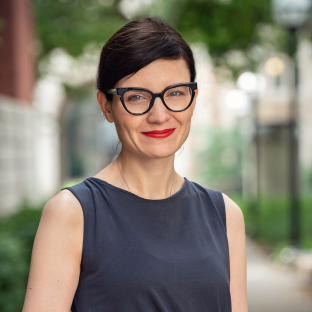Topographies of Yiddish Warsaw
Tuition: $200 | YIVO members: $150**
Registration is closed. Sign up for YIVO's email list to receive announcements of upcoming classes.
This is a live, online course held on Zoom. Enrollment will be capped at about 25 students. All course details (Zoom link, syllabus, handouts, recordings of class sessions, etc.) will be posted to Canvas. Students will be granted access to the class on Canvas after registering for the class here on the YIVO website. This class will be conducted in Yiddish, and any readings will be in Yiddish.
Instructor: Karolina Szymaniak
In this workshop we will consider the question of how a concrete, physical space, with its specific forms, smells and sounds, helped fashion various cultural and literary activities (or, more technically speaking, practices) in pre-WWII Warsaw. Many of us have heard of the Nalewki and Tłomackie and know more or less the geography of the former Jewish neighborhood; rarely, however, are we capable of saying much more about its topography. At what tables did one sit at this or that café? How does one find a specific place on the map? Where is it today? Is there a trace in contemporary Warsaw of what once was? Or more concretely: was Tłomackie a typical street? How far from it did "the regulars" live who populated the Union of Yiddish Writers and Journalists? Did one get there on foot or by streetcar? Where, for example, did the well-known photographer and writer Alter Kacyzne live, and why was his place a site of social gathering into the wee hours? In which café did Itsik Manger while the time away and why? What was the menu there? And how did all of that influence Warsaw's Yiddish cultural life?
In class we will concentrate on the topography of the intersection of Leszno-Tłomackie-Przejazd-Długa-Nowolipki, a distinct grid of streets in the very center of Yiddish Warsaw. We will utilize various documents: texts from literature and the press, archival documents, old and new maps (including Google Maps), photographs, and drawings.
טאָפּאָגראַפֿיעס פֿון ייִדיש־וואַרשע
אין דעם וואַרשטאַט וועלן מיר באַטראַכטן די פֿראַגע ווי אַזוי אַ קאָנקרעטער פֿיזישער שטח, מיט זײַנע ספּעציפֿישע פֿאָרמען, ריחות און קלאַנגען, האָט מיטגעשטאַלטיקט פֿאַרשיידענע קולטורעלע און ליטעראַרישע אַקטיוויטעטן (אָדער „טעכנישער” געזאָגט: פּראַקטיקעס) אין פֿאַרמלחמהדיקן וואַרשע.
אַ סך פֿון אונדז האָבן געהערט פֿון די נאַלעווקעס און טלאָמאַצקע און קענען מער־ווייניקער די געאָגראַפֿיע פֿון דער אַמאָליקער ייִדישער שטאָט. זעלטענער אָבער זענען מיר מסוגל עפּעס מער צו זאָגן וועגן איר טאָפּאָגראַפֿיע. בײַ וואָסערע טישן פֿלגעגט מען זיצן אין דעם צי יענעם קאַפֿע? ווי אַזוי געפֿינט מען דעם צי יענעם אָרט אויף דער מאַפּע? וווּ איז עס הײַנט? צי איז אין דער הײַנטיקער שטאָט געבליבן עפּעס אַ שפּור פֿון דעם אַמאָל? אָדער קאָנקרעטער גערעדט: צי איז טלאָמאַצקע געווען אַ געוויינלעכע גאַס? ווי ווײַט פֿון טלאָמאַצקע האָבן געוווינט די שטאַמגעסט – ד"ה די אײַנגייערס – אין לאָקאַל פֿונעם פֿאַראיין פֿון ייִדישע שרײַבער און זשורנאַליסטן? צי איז מען אַהין אָנגעקומען צו פֿוס אָדער האָט מען גיכער גענומען אַ טראַמווײַ? וווּ, למשל, האָט געוווינט אַלטער קאַציזנע, דער באַוווּסטער פֿאָטאָגראַף און שרײַבער, און פֿאַר וואָס פֿלעגט מען דווקא בײַ אים פֿאַרברענגען ביז שפּעט בײַ נאַכט? אין וועלכן קאַפֿע פֿלעגט איבערזיצן איציק מאַנגער און פֿאַר וואָס? וואָס איז געווען דער מעניו דאָרטן? און ווי אַזוי האָט דאָס אַלץ משפּיע געווען אויף דעם וואַרשעװער ייִדישן קולורעלן לעבן?
אין קלאַס וועלן מיר זיך קאָנצענטרירן אויף דער טאָפּאָגראַפֿיע פֿון דעם גאַסנקנופּ לעשנע־טלאָמאַצקע־פּשעיאַזד־דלוגע־נאָוואָליפּקי, אַ באַזונדער געפֿלעכט פֿון גאַסן אין סאַמע צענטער פֿון ייִדיש־וואַרשע. מיר וועלן זיך באַניצן מיט פֿאַרשיידענע דאָקומענטן: ליטעראַרישע און פּרעסע־טעקסטן, אַרכיוואַלע דאָקומענטן, אַלטע און נײַע מאַפּעס (גוגל־מאַפּס בתוכם), פֿאָטאָגראַפֿיעס און צייכענונגען.
Yiddish Level:
This course is for intermediate students. It is appropriate for those who have taken the equivalent of level Giml or above in the YIVO Summer Program. It is also appropriate for those who completed Intermediate II Yiddish, Intensive Intermediate I&II Yiddish, or above in fall 2021.
Course Materials:
The instructor will provide all course materials digitally throughout the class on Canvas.

Karolina Szymaniak is assistant professor at the Jewish Studies Department at the University of Wrocław and Research Fellow at the Jewish Historical Institute. Her research interests range across modern Yiddish literature, Polish-Jewish cultural relations, and translation studies. In addition to having taught Yiddish language and culture throughout Poland and Europe, she has also served as a consultant for the POLIN Museum and the Museum of Modern Art in Łódz. Her recent publications include Montages. Debora Vogel and the New Legend of the City and My wild goat. Anthology of women Yiddish poets (in Polish). She is also the editor of Rachel Auerbach's ghetto writings, which received the 2016 Polityka History Award.
**Become a member today, starting at $54 for one year, and pay the member price for classes! You’ll save on tuition for this course and more on future classes and public programs tickets.





